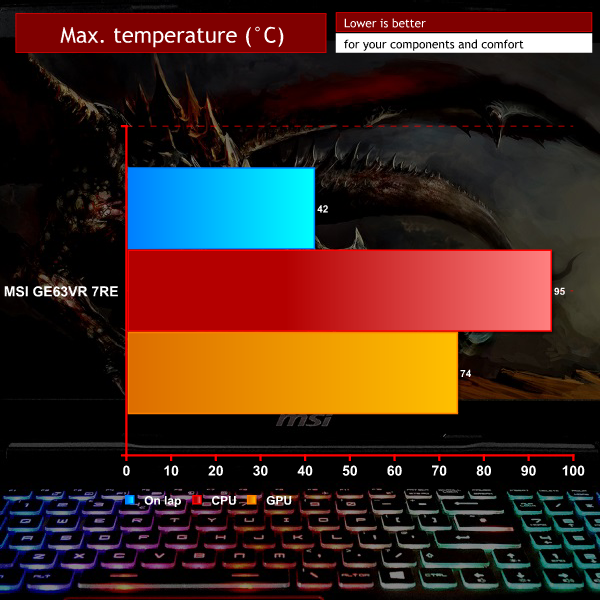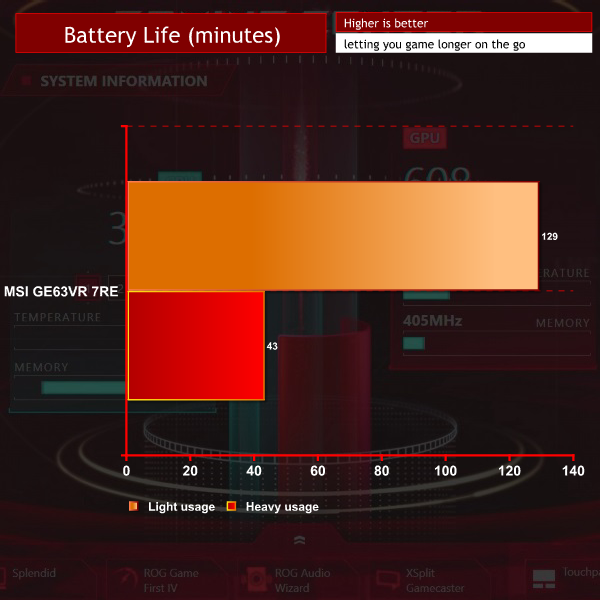MSI GE63VR 7RE – Thermal Performance
Our trusty Prime 95 and FurMark combo pushed temperature on this Raider’s Intel Core i7-7700HQ up to a rather worrying 95°C, nearing the 100°C thermal limit of the chip. Thankfully this kind of load is unlikely in most real-life use, but we would recommend keeping an eye on this if you’re going to be stressing it out.
In a sensible move for a gaming machine, MSI seems to have focused most of the power of its Cooler Boost 5 solution on the GPU, which never reached higher than 74°C. Interestingly, activating the aforementioned maximum cooling switch (or the maximum noise switch, as we prefer to call it) took those temps down to 94°C /70°C, with the fans for both running between 4200-4800rpm.
Unlike its internal bits, most of the laptop’s base remained fairly cool meaning it should be comfortable on the lap. Do note that heat gets exhausted from four different main grills: one to the left, two to the rear, and one to the right, so the only heat-free area is the laptop’s front. We used a laser IR thermometer to measure the main chassis’ temperature at six points on the top and bottom. Below are the results rounded to the nearest degree Celsius.
| BOTTOM | ||
| 29 | 25 | 27 |
| 42 | 29 | 27 |
| TOP | ||
| 34 | 39 | 33 |
| 26 | 25 | 38 |
Temperature guide:
<30°C – Comfortable for long periods
<40°C – Noticeable heat but comfortable depending on other factors
<50°C – Uncomfortable heat, prolonged exposure may be painful
>50°C – Likely be highly uncomfortable or painful
MSI GE63VR 7RE – Power Consumption
At idle, the GE63VR 7RE draws an average of between 29-65W. Average under load was around 178W, while the highest we measured from the wall was 184W. This is with the screen at maximum brightness and GPU/CPU under full load.
MSI GE63VR 7RE – Battery Life
MSI has fitted its Raider laptop with an own-brand non-removable 53Wh lithium ion battery with a chargeable capacity of around 46300mWh/4289mAh. This is not a huge offering for what’s being driven here and, concomitantly, battery life isn’t stellar. To be fair that’s the case for the vast majority of ‘proper’ gaming laptops, but we must admit the results here are below even that unimpressive average.
With screen brightness set to 120cd/m2 the battery only lasted 129 minutes in the Reader test, which reflects light usage. Running an intensive test to simulate gaming with the screen at maximum brightness, the GE63VR 7RE managed just 43 minutes, so this may not be the best machine if you’re looking for something that will last you for long train or plane journeys without a power outlet.
 KitGuru KitGuru.net – Tech News | Hardware News | Hardware Reviews | IOS | Mobile | Gaming | Graphics Cards
KitGuru KitGuru.net – Tech News | Hardware News | Hardware Reviews | IOS | Mobile | Gaming | Graphics Cards






Why would anyone pay £1497 for this with a GTX 1060 when you can get a Gigabyte with an I7 and a GTX 1070 for £1499? https://www.overclockers.co.uk/gigabyte-p57x-v7-cf2-nvidia-gtx-1070-8gb-gddr5-17.3-fhd-ips-intel-i7-7700hq-gaming-laptop-lt-07s-gi.html
120Hz screen. 60Hz is cancer in comparison
I concur. Yet there is no point matching a GTX 1060 with 120Hz display. Unless medium settings is more appealing?
People chose 120hz for competitive gaming, not casual single player games because there is no point in there. Also no one use high settings in any competitive game like CS: GO, Overwatch, therefore 1060 can push 120 hz easily.